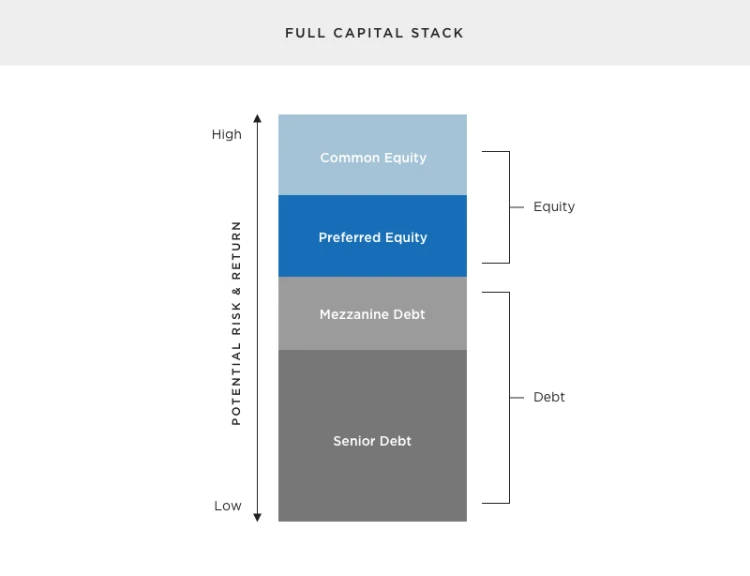Real estate investing doesn’t have to be complicated. This article breaks down a fundamental concept in real estate investing, the capital stack.

What is the Real Estate Capital Stack & How Does It Work?
The capital stack is most commonly made up of 4 layers: Senior Debt, Mezzanine Debt, Preferred Equity, and Equity.
Each layer in the capital stack has a different risk and returns profile. Senior Debt is the least risky but also provides the lowest returns. And Equity is the riskiest but has the greatest potential upside.
Each layer has advantages and disadvantages and serves a specific purpose in real estate investing.
Whether investing in real estate crowdfunding or publicly traded REITs, understanding the capital stack can make you a more educated investor and help you build wealth through real estate investing.
When analyzing a potential investment, too many investors become enamoured with the potential upside while glazing over the associated risk.

Senior Debt: The Foundation
Senior Debt is the largest and least risky layer of the Capital Stack. Senior Debt can comprise 50% – 80% of a commercial real estate investment’s purchase price.
Senior Debt holders are first in line in the case of default. Investments are collateralized by a deed of trust or mortgage against the property, meaning Senior Debt holders can claim the title in the case of a borrower default. And because senior debt holders can claim the title, the physical collateral provides a level of security for investors.
Plus, Senior Debt is structured to require monthly interest payments at a predetermined rate. Its returns are not tied to the performance of the underlying investment.
For this level of security, Senior Debt holders forgo larger returns for a safer investment and stable income generation.
Pros
- Secured by physical property
- Predetermined interest payment
Cons
- Sensitive to inflation
- Lowest returns compare to other layers in the capital stack
Mezzanine Debt
Next in the capital stack is Mezzanine Debt, which typically comprises 10% – 20% of a real estate deal’s purchase price. Mezzanine debt has the characteristics of Senior Debt and Common Equity.
Like Senior Debt, Mezzanine Debt has the right to receive regular payments not tied to the performance of the underlying real estate investment. And like Common Equity, Mezzanine Debt investors can share a portion of any profits, albeit at a considerably lower level than the equity layer.
Mezzanine Debt provides higher returns to investors than Senior Debt because of its increased risk. It is not secured by property and has limited foreclosure rights.
Interestingly, Mezzanine Debt can have fixed or floating interest rates, which can vary depending on the Loan-to-Value (LTV) of the real estate deal.
Investors in Mezzanine debt can earn between 10% – 20% returns, making this layer in the Capital Stack very attractive to real estate investors.
Pros
- Higher payment than senior debt because of increased risk
- Can share in the potential upside while also securing guaranteed payment.
Cons
- Limited foreclosure rights
- Lowest returns compare to other layers in the capital stack
Preferred Equity
Is a hybrid structure that shares characteristics of Common Equity and Mezzanine Debt and makes up 5% – 20% of a real estate deal purchase price. Preferreds are usually structured as ‘hard’ Preferred, which is less risky, or ‘soft’ Preferred, which is riskier and more ‘equity-like.’
If Preferred Equity is structured as ‘hard,’ it means that payments must be paid regardless of cash flow or performance. If payments are not made, specific remedies include taking control of the investment or forcing its sale, making hard preferred similar to Mezzanine Debt and therefore less risky.
If Preferred Equity is structured as ‘soft,’ it means payments are only required if there is sufficient cash flow. There may or may not be remedies if payments are not made, thus making it similar to the Common Equity layer.
Pros
- Safer return
Cons
- Principal at risk
Common Equity: The Icing On The Cake
At the very top of the capital stack is Common Equity, the icing on the cake. Common Equity investments in real estate are the riskiest layer, but they also offer the opportunity for the highest returns. It comprises 5 – 10% of a real estate deal’s purchase price..
Because equity investments do not have a secured interest in the property, nor are they entitled to recurring payments making it possible to lose some or all of your initial investment.
Potential returns in equity investments are usually not capped, and investors receive returns only after the lower tiers of the capital stack are repaid.
Gains from equity investments are from appreciation, and investors usually will not realize returns until the property is sold or a liquidity event occurs.
When you invest in the equity layer of the capital stack, you are usually invested at the same level as the sponsor, colloquially known as ‘skin in the game,’ thus incentivizing the sponsor to maximize returns.
Pros
- Greatest upside potential
Cons
- Riskiest level of investment
Why does the Capital Stack Matter?
From an investor’s perspective, understanding the capital stack is critical because it can help an investor determine how much risk they are taking on and the expected returns that can be generated. All commercial real estate investments are comprised of some combination of the capital stack.
If you are an individual investor who has many years until retirement, you may be more inclined to invest in the equity layer as that will generate the largest returns primarily through capital appreciation.
On the other hand, if you are closer to retirement age, investing in debt could be more appropriate as this layer focuses on income generation and is safer because it is secured by the underlying property.

